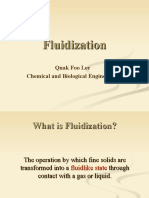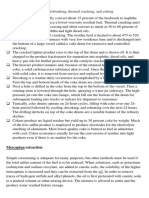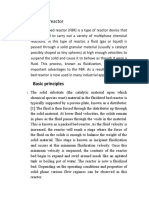Fluid Solids Operations: High High
Fluid Solids Operations: High High
Uploaded by
PriscilaPrzCopyright:
Available Formats
Fluid Solids Operations: High High
Fluid Solids Operations: High High
Uploaded by
PriscilaPrzOriginal Title
Copyright
Available Formats
Share this document
Did you find this document useful?
Is this content inappropriate?
Copyright:
Available Formats
Fluid Solids Operations: High High
Fluid Solids Operations: High High
Uploaded by
PriscilaPrzCopyright:
Available Formats
FLUID SOLIDS OPERATIONS
INTRODUCTION
Fluid bed reactors became important to the petroleum industry with the
development of fluid catalytic cracking (FCC) early in the Second World War.
Today FCC is still widely used. The following section surveys the various fluid
bed processes and examines the benefits of fluidization. The basic theories of
fluidization phenomena are also reviewed.
F'LUID BED PROCESSES
Catalytic Cracking
Cracking is a process for breaking down large, high boiling petroleum molecules
to produce light gases, gasoline, jet fuel, and heating oils. Cracking originally
was a thermal process relying on high temperature to cause reaction. In the early
fixed bed catalytic process, the catalytic process operated at lower temperatures
and produced a more valuable product distribution. Because the reaction was
endothermic and deposited carbon on the catalyst, cyclic operation was necessary
to permit frequent regeneration and reheating of the catalyst. To meet these
reaction needs, a fluid bed process was developed in which very fine catalyst
particles were circulated between a reactor and a regenerator vessel. This
provided much more satisfactory uniform operation and now most catalytic
cracking is carried out in fluid bed processes.
Fluid cat cracking required identifying stable operating regimes for beds of fine
catalyst at high gas flow rates. Highly efficient cyclone and electrostatic systems
had to be developed for catalyst recovery. Finally, the principles of pressure
26
Fluid Solids Operations 27
balancing and standpipe/transfer line flow had to be developed for the catalyst
circulation scheme.
Fluid Hydroforming
As the demand for high octane gasoline increased, reforming processes were
developed. In reforming, low octane normal paraffins are isomerized and/or
aromatized. One process developed was a fluid bed process, called fluid
hydroforming. In concept, it was similar to cat cracking, employing a reactor and
regenerator with solids circulation for regeneration and heat balancing. However,
fluid hydroforming faced some additional problems in the area of gas-solids
contacting. Due to the nature of the process, fluidization was not inherently good
in hydroforming, but at the same time the reaction required better contacting than
FCC to obtain high yields of high octane gasoline. Thus, a large and ultimately
successful program was carried out to improve fluidization and contacting. This
work led to some of the earlier theories explaining the behavior of fluidized beds
as chemical reactors.
While there are hydroformers still operating, reforming today is generally
carried out in fixed bed units using platinum catalysts, because of their superior
product yield and distribution. Fluid platinum catalyst processes are not feasible
because catalyst losses would be too great.
Fluid Coking
Coking is a thermal process for converting heavy, residual oils into lighter
products and solid carbon. In the earliest coking process, called delayed coking,
after heating and partial vaporization, the residuum is passed into a coking drum
which fills up with solid coke deposits. This coke must then be drilled out. The
coke can be deposited on particles of seed coke in a fluidized bed, and the coke
product is in the form of freely flowing granules. Fluid coking also employs two
beds with particles circulating between the coking reactor and a burner vessel,
where some coke particles are burned to produce the necessary heat.
Fluid coking is very insensitive to poor gas-solids contacting, but has one
problem not faced by cat cracking or hydroforming. If the heavy residual oil is
fed too fast to the reactor, the coke particles will become wetted and stick
together in large unfluidizable lumps. Correct control of feed rate is necessary
to prevent this bogging.
28 Pressure Safety Design Practices
FIOR
Fluid Iron Ore Reduction (FIOR) is a process for reducing ore to iron with a
reducing gas in a fluid bed. For thermodynamic efficiency, iron ore reduction
requires counter current flow of ore and reducing gas. This is achieved in FIOR
in a multiple bed reactor. Precautions are necessary to prevent significant back
mixing of solids between beds, since this would destroy counter current staging.
Other Fluidization Processes
Several other processes that are aimed at the manufacture of gasoline from coal
have been applied over the years. The main reactor in these processes uses three
phase fluidization in which solid coal particles, gases, and liquids are all
contacted at very high temperatures and pressures. Fluid bed dryers and fluid
cokers are also used in synthetic fuels manufacture.
Fluid bed boilers have also been applied as a cure to sulfur dioxide air
pollution from power plants. Various schemes have been developed in which
combustion of a sulfur containing fuel takes place in a fluidized bed of particles
which absorb or react with sulfur dioxide. The particles are usually regenerated
to recover sulfur, which often has enough by-product value to make a significant
contribution to process economics.
Several important applications of fluid beds exist outside the petroleum
industry. Fluid bed roasting of pyritic ores is widely used in the metallurgical
industry. Calcination of lime is a commercial process. There are also fluidization
processes for various nuclear processing steps.
Fluid bed processes have been subject to many problems and uncertainties
in development and scale up from bench-scale reactors. The fluidization behavior
of each process seems different and very often does not meet expectations based
on experience with earlier plants. With hindsight fluid cat cracking seems to be
an ideal system from the point of view of easy operation and straightforward
scale up.
BEHAVIOR OF FLUIDIZED BEDS
Qualitative Aspects of Fluidization
When a fluid flows upward through a bed of solid particles, pressure drop across
the bed increases as the flow rate increases. Eventually the pressure drop equals
the weight of the bed (per unit horizontal area) at which point the particles are
Fluid Solids Operations 29
suspended by the flowing fluid, and the bed is said to be "fluidized". In this state,
the particles in the bed are able to move freely instead of resting on each other,
and the bed behaves much like a liquid. Waves can be generated and propagated
along the surface of the bed. A large low density solid object will float on the
surface of the bed. Particles will flow like a liquid between vessels and will
stream in a jet from a hole in the side of the bed.
As the fluid flow rate is increased beyond the minimum fluidizing velocity,
the bed expands. The total pressure drop across the bed remains essentially
constant, but the pressure drop per unit height decreases as shown in Figure 1.
At flow rates above the minimum for fluidization, bed characteristics depend
greatly on whether the fluid is a liquid or a gas. For most liquid fluidized
systems, the bed expands uniformly, with particles being well dispersed
throughout. For most gas fluidized beds the gas flow in excess of minimum
fluidization will pass up through the bed as bubbles. These bubbles have many
of the properties of gas bubbles in liquids. The bubbles contain very few
particles. Most particles remain in the "emulsion phase," packed closely together
as they were at minimum fluidization conditions.
Fluidized beds have a number of properties which make them desirable in
certain reaction and processing steps. They permit the use of fine particles, which
have very large surface areas for catalysis and gas-solids contacting. A packed
bed of fine particles would have a prohibitively high pressure drop at reasonable
gas velocities. Solids are well mixed so that temperatures throughout the bed are
uniform even when very exothermic or endothermic reactions are occurring. In
addition, heat transfer between the fluid bed and exchanger surfaces is high. The
ease of handling fluidized solids makes feasible the continuous addition and
removal of solids.
A number of disadvantages are also associated with fluidized beds, although
proper design can often minimize them. Perhaps of greatest concern is the
problem of contacting. The gas in bubbles is not in intimate contact with solids,
and the bubbles have comparatively short residence times in the reactor, thus,
bypassing often occurs. The seriousness of this depends on the size and velocity
of the bubbles, the design of the reactor, and the kinetics of the desired reaction.
Flow patterns, particularly for solids, approach those in stirred tanks rather than
those in plug flow reactors, an undesirable feature if high conversion is desired.
This, of course, can be remedied by staging several fluid beds in series. Sticky
or agglomerating materials often prove hard to handle in fluid beds. Entrainment
of f i e particles can cause serious solid losses and air pollution if efficient
recovery devices are not provided. For some low pressure processes, such as
burners, pressure drop may be substantially higher for a fluid bed (because the
gas supports the solids) than for the more conventional process. Bubbles make
30 Pressure Safety Design Practices
Figure 1. Pressure drop in fluid beds.
Fluid Solids Operations 31
an important contribution to the behavior of most fluidized beds.
Bubble Formation and Rise Velocity
When a gas is blown steadily through an orifice into an essentially inviscid liquid,
a regular stream of bubbles is formed. A theoretical expression that relates the
bubble volume V to volumetric gas flow rate G and gravitational acceleration g
is the following:
(1)
V = 1.138 (G) ' I s
This equation has been experimentally verified in liquids, and Figure 2
shows that it applies equally well for fluidized solids, provided that G is taken as
the flow rate in excess of minimum fluidization requirements. In most practical
fluidized beds, bubbles coalesce or break up after formation, but this equation
nevertheless gives a useful starting point estimate of bubble size.
Single gas bubbles in an inviscid liquid have hemispherical leading surfaces
and somewhat flattened wakes. Their rise velocity is governed by Bernoulli's
theory for potential flow of fluid around the nose of the bubble. This was first
solved by G. I. Taylor to give a rise velocity U, of :
U, = 0 . 7 1 m
where D,, is the equivalent bubble diameter. By means of X-ray photography,
this has been verified for bubbles in fluidized beds, although there is some
variation in the coefficient.
When the bubble diameter approaches the diameter of the containing vessel,
slug flow is said to exist. In such cases, the bubble rise velocity is given by
U, =0.35m (3)
where D is the vessel dlameter. Slug flow occurs very often in laboratory sized
equipment. This is a major contributing factor to scale up effects, since bubble
behavior is directly related to vessel size.
Bubble Rise During Continuous Fluidization
Bubbles in liquids rise at velocity U, relative to the surrounding fluid. This fluid
itself moves upward at velocity U when gas is introduced at superficial velocity
32 Pressure Safety Design Practices
Figure 2. Bubble formation at an orifice.
Fluid Solids Operations 33
U to the bottom of the bed. The absolute velocity of a bubble as seen by a
stationary observer is then
For fluidized beds, part of the gas flows through the emulsion at minimum
fluidization velocity U,, leaving U - U, to influence bubble behavior. Then
equation (4) is modified to read :
( 5)
UA = u, + ( U- UJ
Bed Height and Density
Knowing the bubble rise velocity, the bed expansion can be predicted from a
material balance on the bubble phase gas. Thus, total gas flow through the bubble
phase equals absolute bubble velocity times the volume fraction E of bubbles in
the bed.
The fraction q can be expressed in terms of the expanded bed height H and
minimum fluidization height H,, and terms may be substituted for U,.
(U UJ = ( U B + U UJ (H-HJIH (7)
This may be solved to give the expansion compared to minimum fluidization
conditions.
where p, and p are bed densities at minimum fluidizing and actual
conditions.
Equation 8 has not been rigorously tested on freely bubbling beds because
of the difficulty of making precise independent measurements of D, or U, under
such conditions. It has been verified for slugging beds, however, as is shown in
Figure 3. In the case of slugging, the surface level of the bed oscillates
considerably, and in this case, the maximum bed height H,, is used for H in
Equation 8.
34 Pressure Safety Design Practices
Figure 3. Bed expansion data.
Fluid Solids Operations 35
Bubble Clouds and Contacting
At any instant, pressure is uniform throughout a bubble, while in the surrounding
emulsion pressure increases with depth below the surface. Thus, there is a
pressure gradient external to the bubble which causes gas to flow from the
emulsion into the bottom of the bubble, and from the top of the bubble back into
the emulsion. This flow is about three times the minimum fluidization velocity
across the maximum horizontal cross section of the bubble. It provides a major
mass transport mechanism between bubble and emulsion and hence contributes
greatly to any reactions which take place in a fluid bed. The flow out through the
top of the bubble is also sufficient to maintain a stable arch and prevent solids
from dumping into the bubble from above. It is thus responsible for the fact that
bubbles can exist in fluid beds, even though there is no surface tension as there
is in gas-liquid systems.
The flow pattern of gas within the emulsion phase surrounding a bubble
depends on whether the bubble velocity U, is less than or greater than minimum
fluidization velocity U,. For U,< U,, Figure 4(A) is representative. The presence
of the void of the bubble causes a distortion of the gas flow lines. For U, > U,,
the much different case of Figure 4(B) results. Here a gas element which leaves
the bubble cap rises much more slowly thanthe bubble, and as the bubble passes,
it returns to the base of the bubble. Thus, a cloud of captive gas surrounds a
bubble as it rises. The ratio of cloud diameter to bubble diameter may be written
In addition to thi s convective cross flow of gas from the bubble into the emulsion
phase of the cloud, mass transfer also occurs by diffusion into the emulsion.
The effectiveness of a fluidized bed as a chemical reactor depends to a large
extent on the amount of convective and diffusive transfer between bubble gas and
emulsion phase, since reaction usually occurs only when gas and solids are in
contact. Often gas in the bubble cloud complex passes through the reactor in plug
flow with little back mixing, while the solids are assumed to be well mixed. Actual
reactor models depend greatly on kinetics and fluidization characteristics and become
too complex to treat here.
Coalescence
In a freely bubbling fluidized bed, small bubbles often tend to coalesce into larger
36 Pressure Safety Design Practices
Figures 4. Gas flow through bubbles.
Fluid Solids Operations 37
ones. This can occur when a bubble enters the wake region of the bubble above it.
The wake of a bubble moves upwards with the bubble, and when a trailing bubble
enters a wake region, it moves at U, relative to the solids in the wake, which are
already moving at U,. The trailing bubble is thus sucked up into the leading bubble.
With the possibility of coalescence, the picture suddenly becomes more complex,
because bubble velocities and sizes are no longer constant but change with height in
the bed. Rigorous models for coalescence have not been verified under realistic
fluidization conditions. It is often possible, however, to make educated guesses as to
bubble growth rates so that reasonable calculations can be made.
Maximum Bubble Size
Measurements in large fluidized beds of fine particles indicate that bubble
coalescence often ceases within a short distance above the gas distributor plate.
Indications from density measurements or single bubble velocities are that bubble
velocity U, and diameter I& often reach maximum stable values, which are invariant
with height or fluidizing gas velocity.
Small bubbles give smoother more uniform fluidization and greater bed
expansion thanlarge ones. In addition, they have a greater relative interfacial area for
mass transfer and have a longer residence time in a fluid bed, so that chemical or
physical reaction between gas and solids is enhanced by small bubbles. The
correlation between smooth physical fluidization and good reactor performance had
long been recognized. It was known that increasing gas density and viscosity and
decreasing particle density and size @@$ne$ content) improved reactor behavior.
The theory of maximum stable bubble size can explain why these changes tend to
produce smaller bubbles. Referring to Figure 5, as a bubble rises in a fluid bed, shear
at the bubble-emulsion interface sets up circulation patterns of gas within the bubble.
The circulation velocity is roughly equal to U,. When this velocity approaches the
free fall velocity of particles in the wake, they are entrained into the bubble, and too
much entrainment destroys the bubble. Factors which reduce the free fall velocity of
bed particles therefore reduce the stable bubble size. Figure 6 shows a bubble in the
process of brealung up in this manner. Figure 7 shows the effect of fines content on
bed density and bubble size.
Entrainment
Economic considerations dictate that a commercial fluid bed operates at as high a gas
velocity as practicable. A frequent biting factor is entrainment from the bed which
is a very strong function of gas velocity. A well defined fluid bed can be maintained
even at gas velocities well in excess of the free fall velocity of the biggest particles
38 Pressure Safety Design Practices
Figure 5. Internal circulation and maximum bubble size.
Figure 6. Experimental observation of bubble break-up.
pluld Solids Operations 39
Figure 7. Bed expansion withsmall bubbles.
40 Pressure Safety Design Practices
in the bed. Though entrainment can occur only at a finite rate, the rate can be high,
and entrained particles must be returned to the bed or the bed will rapidly disappear.
Entrainment in the regenerator of a large cat cracker can be as high as 40 tons per
minute, and the importance of efficient entrainment recovery is obvious.
Entrainment may be separated into two zones. Near the bed, it decreases rapidly
with height, but above the so called transport disengapg height (TDH) it is constant.
The primary contribution to entrainment at low heights above a bed is the solids
thrown up from the wakes of large fast moving bubbles when they break the surface.
Gas velocities at the surface vary greatly both in time and with position, and high
velocity streams are capable of carrying large solids concentrations. These streams
dissipate as jets, however, and as they become slower and broader with height above
the bed, their carrying capacity decreases and some of the solids fall back to the bed.
Finally, far enough above the bed, the gas velocities have become uniform, and the
solids have lost any excess kinetic energy due to violent bubble eruptions, so
entrainment reaches a constant level. This explains the seemingly anomalous
observation that entrainment for coarse particles may be greater t han for fine ones.
If entrainment is measured below the TDH, the fluidization behavior of the bed can
be the dominant factor, with coarse particles giving much worse, less uniform
fluiduation characteristics and higher entrainment. Entrainment also depends very
strongly on gas velocity. Figure 8 shows typical entrainment rates for cat cracking
catalyst and fluid coke.
Heat Transfer
Fluid beds have very favorable heat transfer characteristics in three important modes:
thermal conduction within the bed; heat transfer between gas and solids; and heat
transfer between bed and heat transfer surfaces. Thermal conductivity within the bed
depends to a large extent on specific solids flow patterns and gas bubbling
characteristics. It usually is greater in large units than in small ones. Temperature
differences between points in a uniformly fluidized bed are never more thana few
degrees, and any greater differences are usually strong evidence of malfunctioning
of the bed.
Heat transfer between gas and solids is exceedingly hard to measure because it
is so rapid. Although the coefficient is low, the available surface area and the relative
specfic heat of solid to gas are so large that temperature equhbration occurs almost
instantanmly. Experiments on injection of argon plasmas into fluidized beds have
shown quenching rates of up to fifty million degrees Kelvin per second. Thus, in a
properly designed bed, gas to solids heat transfer is not normally a matter of concern.
Heat transfer from surfaces to a fluidized bed is a strong function of the rate at
Fluid Solids Operattons 41
Figure 8. Typical entrainment.
42 Pressure Safety Design Practices
Figure 9. Fluid solid system model IV catalytic cracking unit.
Fluid Solids Operations 43
which parbcles reach the surface. This in turn depends on the size of the vessel, the
geometry of the heat transfer surface, and the @ty of fluidization.
DESIGN CONSIDERATIONS FOR FLUID BED SYSTEMS
Many factors enter into the design of a fluid bed reactor which are unlcnown in more
familiar reactor types. These can be illustrated with reference to fluid catalytic
cracking.
A typical cat cracker is shown in Figure 9. Gas oil is fed to the reactor (right
hand vessel). It contacts the hot finely divided catalyst in the reactor, and is
vaporized and broken down catalytically into smaller molecules mostly in the
gasoline boiling range. The product gases leave the fluid bed, and after passing
through cyclones which remove entrained catalyst, leave the reactor and are sent to
fractionation. The reaction is endothermic, and it deposits a carbonaceous residue on
the catalyst particles which reduces the catalytic activity. The catalyst is therefore
continuously removed for regeneration and reheating. It passes down through the
reactor stripper in which unconverted hydrocarbons are removed and then through
a standpipe and transfer line to the regenerator vessel. Here air is used as the
fluidizing gas, and the coke deposits are burned off the catalyst particles. The burning
is highly exothermic and provides the heat necessary for the cracking reaction. The
hot regenerated catalyst is then returned to the reactor.
Particle Size Selection
When particle size can be set by the designer, the optimum balance between good
fluidization and low levels of entrainment usually dictates a size in the 40-80 micron
range, as is used in cat cracking. In a case such as Fluid Iron Ore Reduction (FIOR),
the particles are reactants, and costs of crushing iron ore dictate the use of much
larger particle sizes. In fluid coking, good fluidization and contacting are not very
critical, and particles of 2o(r1000 microns are used. For fluid bed boilers, very high
gas velocities may be necessary for economically sized vessels, and particles several
millimeters in diameter might be considered.
Bed Design
Permissible gas velocities are usually set by entrainment, and for a given throughput
the vessel diameter is thus determined. The amount of catalyst or other bed particles
is set by reaction kinetics and the bubble-solids contacting expected. Very often there
is a scale-up debit involved in fluid bed reactors. As mentioned earlier, small reactors
44 Pressure Safety Design Practices
are often in slug flow, where reactor diameter determines fluidization behavior, and
in such units bed diameter limits bubble size. Large reactors thus give bigger bubbles
and less gas-solids contacting than small ones. Some large reactors are subject to gulf
stream flow in which most of the gas passes up through the center of the bed and
solids circulate rapidly up the center and down at the walls. Gulf streaming can also
cause scale-up debits because it permits bubbles to channel very rapidly up through
the center of the bed, again giving poor contacting. Fortunately in cat cracking,
bubbles are usually small, and gulf streaming is normally absent so that scale-up
problems are not as critical as in some less well behaved processes. With the amount
of catalyst known, bed height can be determined from the bed density relationships
outlined earlier. Bed height is often controlled by overflow wells for particle
removal.
Grid Design
The first requirement of the grid is that it distribute gas evenly across the fluid bed.
This is accomplished by having a large number of holes and a high pressure drop
across the grid. The high pressure drop assures that flow will be uniform through all
holes and that flow stability will not be much influenced by behavior of the fluid bed.
Often grid design is primanly dictated by the peculiarities of the specific process
under consideration. Some typical problems which have dictated grid design include
erosion or fouling due to particles carried up through the grid by fluidizing gas,
dumping from one bed to a lower one, formation of reaction deposits on upper
surfaces, and physical support of a large bed at very high temperatures.
Outage and Cyclone Selection
The vertical &stance between the bed surface and the inlet to cyclones is known as
outage. Two factors usually determine outage. First of all, entrainment is a strong
function of outage up to the TDH, and too low anoutage can put very serious loads
on the cyclone systems. Secondly, there is an appreciable pressure drop in the
cyclones, which hinders the tendency of solids to flow from the cyclones back into
the bed. Solids return to the bed is achieved because the solids build up hydrostatic
pressure in the cyclone diplegs, and they will flow back to the reactor if the diplegs
are long enough. Since most cyclones are mounted internally, the dipleg length can
dictate the vessel height and outage.
Perhaps the most important concern in cyclone selection is that they have the
required collection efficiency. In a large cat cracker, two stages of cyclones in series
must have a combined efficiency of 99.99% to keep catalyst losses to an acceptable
Fluid Solids Operations 45
level of 5 tons per day. Efficiency can be increased by higher gas velocity, by smaller
cyclone diameter, and by selection of high efficiency geometry rather than a high
throughput type.
Minimum cyclone diameter is about 3 ft. based on maintenance considerations.
Most cyclones are installed inside reactor vessels, and problems of geometric layout
of multiple cyclones also can affect the size and hence the number of cyclones
selected.
The penalty of higher efficiency is usually higher pressure drop. Pressure drop
through cyclones is of some concern because of gas compression costs. A more
critical reason is usually the effect on dipleg operability and length mentioned
previously.
Standpipe and Riser Operation
Catalyst is transferred between reactor and regenerator vessels through standpipes and
risers. Particles flow out of a vessel downward through a standpipe, which is aerated
with a small amount of gas. Bulk density in the standpipe is fairly high, and the
hydrostatic pressure produced at the bottom is substantial. The particles then go
through a U bend and up through a transfer line. The transfer line is aerated with a
high gas flow, and this causes the density there to be much lower than in the
standpipe. This resulting pressure inbalance causes the desired catalyst flow.
Accurate pressure balances between vessels across the standpipe/riser loops are
essential to proper design of a fluid solids unit.
You might also like
- Type of Reactor UsedDocument7 pagesType of Reactor UsedAzrul Sofi100% (1)
- FCCU Reactor and Transfer Line CokingDocument4 pagesFCCU Reactor and Transfer Line Cokingsaleh4060No ratings yet
- Disadvantages of Fixed and Fluidised BedDocument2 pagesDisadvantages of Fixed and Fluidised BedparghhNo ratings yet
- Chapter IIIDocument45 pagesChapter IIIKarenRosioMoreiraCruzNo ratings yet
- Upper Dilute Zone in Fluidized BedsDocument44 pagesUpper Dilute Zone in Fluidized BedsDaniel Z JucaNo ratings yet
- Fluidization 2Document48 pagesFluidization 2Nabeel SiddiqueNo ratings yet
- Cracking, Visbreaking, Coking and PropertiesDocument12 pagesCracking, Visbreaking, Coking and Propertiesteyiv23540No ratings yet
- Different Zones in The Reactor-Chemistry of GasificationDocument6 pagesDifferent Zones in The Reactor-Chemistry of GasificationN.R. RishiNo ratings yet
- Fluidization Part 1Document2 pagesFluidization Part 1mohammadtalhaijazNo ratings yet
- A Review On Ash Agglomeration Phenomenon in Fluidised Bed Combustion BoilerDocument9 pagesA Review On Ash Agglomeration Phenomenon in Fluidised Bed Combustion BoilerijsretNo ratings yet
- Fluidisation: Stages in Fluidisation or Fluidisation CharacterisationDocument6 pagesFluidisation: Stages in Fluidisation or Fluidisation Characterisationdevilturn70No ratings yet
- Figure 1: Basic Design of Fluidized-Bed ReactorDocument3 pagesFigure 1: Basic Design of Fluidized-Bed ReactorElany Whishaw0% (1)
- Introduction of FLuidizationDocument2 pagesIntroduction of FLuidizationMarilynYunLingNo ratings yet
- Fluidbed ReferenceDocument37 pagesFluidbed ReferenceAzharuddin_kfupmNo ratings yet
- SPECIAL REPORT Molecular SieveDocument8 pagesSPECIAL REPORT Molecular Sievenitoxxx666No ratings yet
- Molecular Sieve Dehydration UnitsDocument8 pagesMolecular Sieve Dehydration UnitsZayn AhmedNo ratings yet
- Circulating Fluidized Bed ThesisDocument7 pagesCirculating Fluidized Bed Thesisuiwbjujef100% (2)
- Chemical Reactors: Batch Reactors Are Used For Most of The Reactions Carried Out in A Laboratory. The Reactants AreDocument4 pagesChemical Reactors: Batch Reactors Are Used For Most of The Reactions Carried Out in A Laboratory. The Reactants AreBranco RojasNo ratings yet
- مجموعة1Document19 pagesمجموعة1جعفر ذيابNo ratings yet
- Toe To Heal Air Injection - THAIDocument5 pagesToe To Heal Air Injection - THAIAnthon100% (2)
- Short Contact Time Review PapeprDocument74 pagesShort Contact Time Review PapeprMukthiyar SadhullahNo ratings yet
- FluidizationDocument33 pagesFluidizationNaufalNo ratings yet
- Fluidized Bed TechnologyDocument34 pagesFluidized Bed TechnologyRajiv Kr Gogoi50% (2)
- Tolaz Yasin. Reactor ReportDocument11 pagesTolaz Yasin. Reactor ReportAram Nasih MuhammadNo ratings yet
- Fluidized Bed Reactor (FBR) : BY Paresh Patel Roll No.:-20 (MS) 3 Semester Materials Science Date: - 27-8-2008Document22 pagesFluidized Bed Reactor (FBR) : BY Paresh Patel Roll No.:-20 (MS) 3 Semester Materials Science Date: - 27-8-2008Tvarit PatelNo ratings yet
- Presentation On Bubble Column Reactor: Presented byDocument19 pagesPresentation On Bubble Column Reactor: Presented byShanmugapriyaNo ratings yet
- Flud ZedDocument10 pagesFlud Zedashe zinabNo ratings yet
- Mechanical Separation TechDocument21 pagesMechanical Separation TechNkugwa Mark WilliamNo ratings yet
- SPE 166261 Distributed-Flux Burners Improve Life of Firetubes and Process Throughput in Heater TreatersDocument11 pagesSPE 166261 Distributed-Flux Burners Improve Life of Firetubes and Process Throughput in Heater TreatersDavid HerreraNo ratings yet
- Reactors1 31Document2 pagesReactors1 31Mourad kharbachNo ratings yet
- Recrystallization Process For The Upgrading of Rock-And Solar SaltsDocument17 pagesRecrystallization Process For The Upgrading of Rock-And Solar SaltsVirgil CenariuNo ratings yet
- Mren.201800026 - Revised MSDocument56 pagesMren.201800026 - Revised MSZahir HussainNo ratings yet
- Fluidized Bed ReactorDocument10 pagesFluidized Bed ReactorDurgesh BondeNo ratings yet
- 2 Chemical Reactor To Reactor Safety PDFDocument41 pages2 Chemical Reactor To Reactor Safety PDFV DhinakaranNo ratings yet
- Fixed and Fluidised Bed 01Document4 pagesFixed and Fluidised Bed 01JimNo ratings yet
- Purpose of Agitation VesselDocument5 pagesPurpose of Agitation VesselMAHAD ZahidNo ratings yet
- Purpose of Agitation VesselDocument5 pagesPurpose of Agitation VesselMAHAD ZahidNo ratings yet
- (8.2) Reactor DesignDocument14 pages(8.2) Reactor DesignAsad SaeedNo ratings yet
- Introduction To Petroleum Technology - 3Document21 pagesIntroduction To Petroleum Technology - 3Anish VazeNo ratings yet
- HydrocrackingDocument4 pagesHydrocrackingdheerajkum2004No ratings yet
- Advances in Condensation Heat TransferDocument85 pagesAdvances in Condensation Heat TransferUttam KarNo ratings yet
- Coatin &ring FormationDocument6 pagesCoatin &ring FormationMustafa RamadanNo ratings yet
- Addis Ababa University Institute of Technology: School of Civil and Environmental EngineeringDocument13 pagesAddis Ababa University Institute of Technology: School of Civil and Environmental Engineeringashe zinabNo ratings yet
- Alhaji Massoud Juma - Petroleum AssignmentDocument9 pagesAlhaji Massoud Juma - Petroleum AssignmentAlhaj MassoudNo ratings yet
- 6 PDFDocument20 pages6 PDFMuhammadNo ratings yet
- Chapter 1 Introduction PDFDocument9 pagesChapter 1 Introduction PDFLuis BorrazNo ratings yet
- Fluidized Bed ReactorDocument10 pagesFluidized Bed ReactornarutosexyboyNo ratings yet
- Catalytic CrackingDocument4 pagesCatalytic Crackingdheerajkum2004No ratings yet
- Chapter 1 ClausDocument13 pagesChapter 1 ClausWoMeiYouNo ratings yet
- Chemical and Mechanical DesignDocument460 pagesChemical and Mechanical DesignNuriman K-monNo ratings yet
- 12.1.2.2 Slurry Reactors: 12.1 Commercially Significant Types of Heterogeneous Catalytic ReactorsDocument1 page12.1.2.2 Slurry Reactors: 12.1 Commercially Significant Types of Heterogeneous Catalytic ReactorsULFA ISLAMIANo ratings yet
- Zeolites As Catalysts in RefiningDocument23 pagesZeolites As Catalysts in RefiningBhupendra PatilNo ratings yet
- Fluidized-Bed Reactors - Kuralay TilegenDocument16 pagesFluidized-Bed Reactors - Kuralay TilegenKuralay TilegenNo ratings yet
- Mixing Succeed at Scale UpDocument9 pagesMixing Succeed at Scale Upicingrock100% (1)
- 1981 - Addison - Large Falling Film EvaporatorsDocument3 pages1981 - Addison - Large Falling Film EvaporatorsshondabagueNo ratings yet
- Fluidized Reactor - ProcessesDocument40 pagesFluidized Reactor - ProcessesLE HIENNo ratings yet
- AssignmentDocument5 pagesAssignmentPorkkodi SugumaranNo ratings yet
- Visbreaking, Thermal Cracking, and Coking: Mercaptan ExtractionDocument4 pagesVisbreaking, Thermal Cracking, and Coking: Mercaptan ExtractionChetan CherryNo ratings yet
- Fluidized Bed Reactor: Basic PrinciplesDocument4 pagesFluidized Bed Reactor: Basic PrinciplesMengist GezehagnNo ratings yet
- How it Works: Dealing in simple language with steam, electricity, light, heat, sound, hydraulics, optics, etc., and with their applications to apparatus in common useFrom EverandHow it Works: Dealing in simple language with steam, electricity, light, heat, sound, hydraulics, optics, etc., and with their applications to apparatus in common useNo ratings yet
- Notification BOB Specialist Officer PostsDocument2 pagesNotification BOB Specialist Officer PostsHemanth Kumar TanguturiNo ratings yet
- Shear-Strength DataDocument19 pagesShear-Strength Datacheveresan123No ratings yet
- Appendix J - Candidate Handbook - TAB Certified Professional - TAB CP - FINAL - 11.1.18Document10 pagesAppendix J - Candidate Handbook - TAB Certified Professional - TAB CP - FINAL - 11.1.18mohdtakrimiNo ratings yet
- Armatura: Basic CommandsDocument4 pagesArmatura: Basic CommandsVladan StojiljkovicNo ratings yet
- Nr410801 Transport Phenomena Set1Document2 pagesNr410801 Transport Phenomena Set1Srinivasa Rao GNo ratings yet
- Isocosts Isoquants and ProofsDocument27 pagesIsocosts Isoquants and ProofsNikita OjhaNo ratings yet
- Refinery OverviewDocument79 pagesRefinery Overviewchikukotwal100% (2)
- Examining Digit Place Value 06-14Document2 pagesExamining Digit Place Value 06-14Janille Tomajin-CapinpinNo ratings yet
- 14_Jr_Snare 24-25Document1 page14_Jr_Snare 24-2529tbrooksNo ratings yet
- The Prosthetic Management of Gingival AestheticsDocument7 pagesThe Prosthetic Management of Gingival AestheticsdentureNo ratings yet
- South Indian BankDocument160 pagesSouth Indian BankHariNo ratings yet
- Ab - Allcare PCD Product SheetDocument44 pagesAb - Allcare PCD Product SheetVicky VPNNo ratings yet
- Cadbury and Nestle: Economic Analysis ofDocument35 pagesCadbury and Nestle: Economic Analysis ofshrey narulaNo ratings yet
- Our Influence As EU CitizensDocument9 pagesOur Influence As EU CitizensDaiana AndreeaNo ratings yet
- Technical Service Information: Automatic Transmission Service GroupDocument2 pagesTechnical Service Information: Automatic Transmission Service GroupVIDAL ALEJANDRO GARCIAVARGASNo ratings yet
- En Iso Mattex Geomatt TB - I-25!08!2013Document1 pageEn Iso Mattex Geomatt TB - I-25!08!2013FarhatNo ratings yet
- Framework of Autonetics IN Attendance Muster Survey and SummarizationDocument10 pagesFramework of Autonetics IN Attendance Muster Survey and Summarizationramalingam rNo ratings yet
- It's A Mushroom LampDocument15 pagesIt's A Mushroom LampRuben SantosNo ratings yet
- SVAB Operator Controls For Heavy Duty Equipment en HDocument15 pagesSVAB Operator Controls For Heavy Duty Equipment en Hdima65No ratings yet
- Ieee STD c37Document55 pagesIeee STD c37marcelo100% (1)
- Matrix Diagram - : L-ShapedDocument6 pagesMatrix Diagram - : L-ShapedSead ZejnilovicNo ratings yet
- Ecm - Engine Control System (Mr20dd)Document416 pagesEcm - Engine Control System (Mr20dd)Eliecer Bayona100% (4)
- Drug StudyDocument8 pagesDrug StudyJuan de Vera100% (4)
- TimDocument12 pagesTimThư Giãn TvNo ratings yet
- The London Polonium Poisoning Events & Medical ImplicationsDocument5 pagesThe London Polonium Poisoning Events & Medical ImplicationsGroze BogdanNo ratings yet
- Outcomes. Pre-Intermediate - Student's Book, 2ndDocument270 pagesOutcomes. Pre-Intermediate - Student's Book, 2ndLoan Nguyễn ThanhNo ratings yet
- Rambam: Tekhelet Tying Detailed InstructionDocument12 pagesRambam: Tekhelet Tying Detailed Instructionapi-85444408100% (1)
- Sheet 5 SolutionDocument36 pagesSheet 5 SolutionJoseph CorderoNo ratings yet
- Carrying Capacity Assessment For SustainDocument41 pagesCarrying Capacity Assessment For SustainShanto Chowdhury100% (2)
- LTE Capacity PlanningDocument18 pagesLTE Capacity Planningrizano bunaiNo ratings yet

























































































